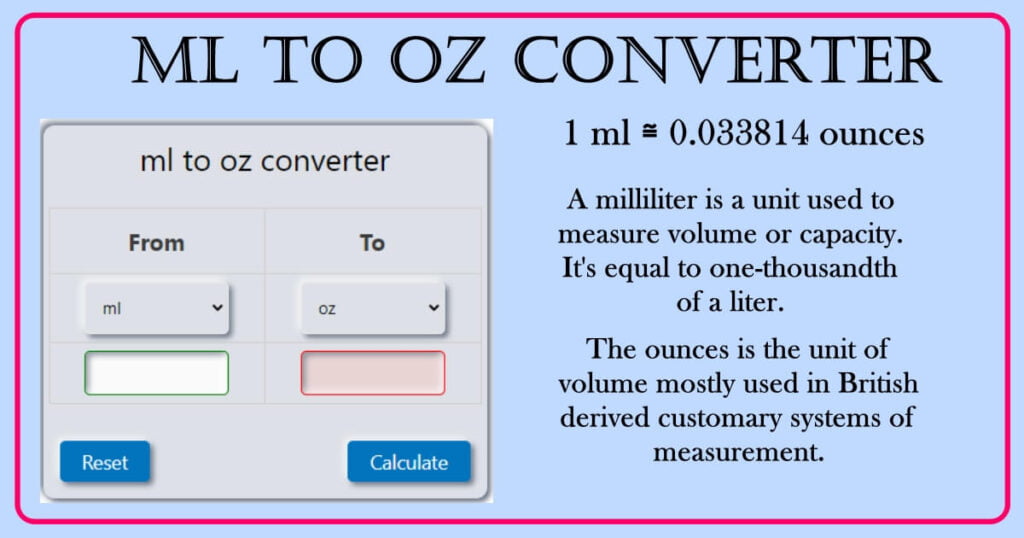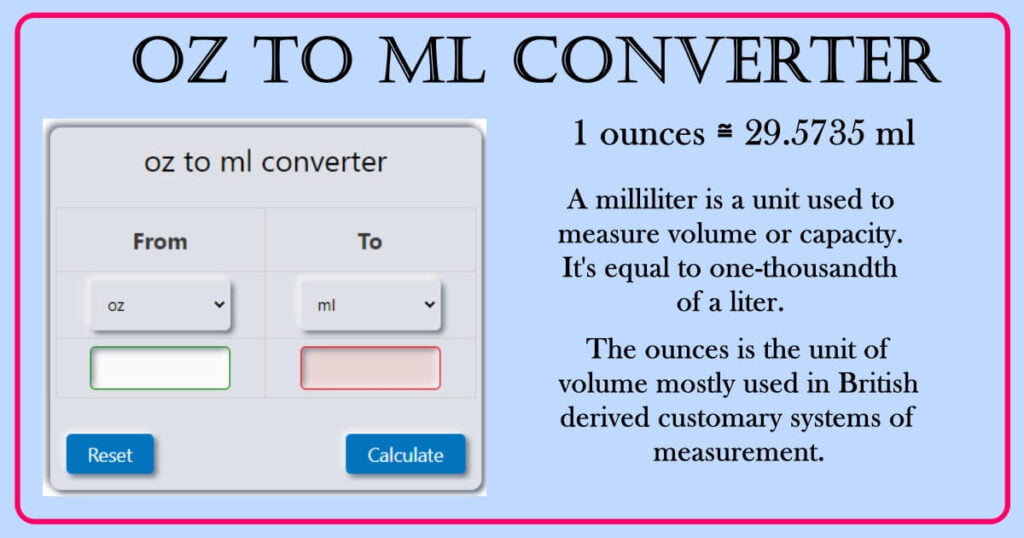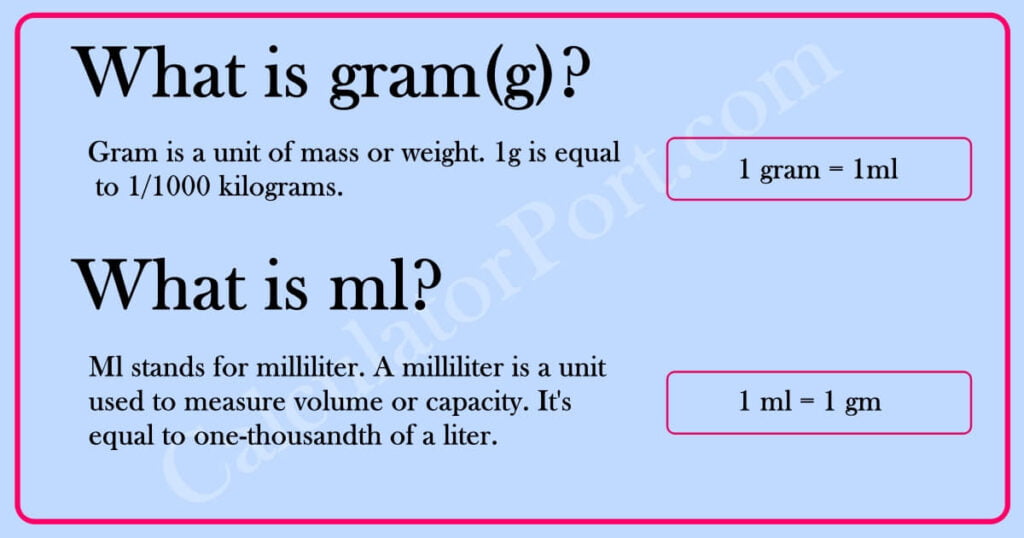Conversion Table
| gram(g) | ml |
|---|---|
| 1 gram(g) | 1 ml |
| 2 gram(g) | 1 ml |
| 3 gram(g) | 3 ml |
| 4 gram(g) | 4 ml |
| 5 gram(g) | 5 ml |

Gram to mL Converter (Grams to Milliliters Calculator): Quick Guide and Practical Uses
Converting between mass (grams) and volume (milliliters) is a common task in cooking, chemistry, pharmacy, and DIY projects. A gram to ml converter helps you convert grams to milliliters by taking into account the density of the substance. This article explains the formulas, provides step-by-step worked examples, lists common densities, and answers frequently asked questions like “how many ml is a gram?” and specific examples such as converting 250 g of olive oil to mL.
Gram to mL Converter (Grams to Milliliters Calculator) Formula
What the converter does
A Gram to mL converter transforms a mass measurement in grams into a volume measurement in milliliters by using the material’s density or specific gravity. Density links mass and volume, making it possible to convert between them for any given substance.
Core formula: grams to milliliters
The primary conversion formula is:
mL = grams ÷ density
Where: – mL = volume in milliliters – grams = mass in grams – density = mass per unit volume in grams per milliliter (g/mL)
This formula assumes density is provided in g/mL, which is common for liquids and many solids when converted by displacement.
Core formula: milliliters to grams
To go the other way, use:
grams = mL × density
Where: – grams = mass in grams – mL = volume in milliliters – density = g/mL
Both formulas are algebraically identical, simply rearranged to solve for the desired variable.
How to calculate Convert mass (grams) to volume (milliliters) using the substance density (mL = grams ÷ density in g/mL)
Step-by-step process to convert grams to mL
Follow these steps to convert grams to milliliters accurately:
- Identify the mass in grams that you want to convert.
- Find the density of the substance in g/mL (use a reliable table or supplier data).
- Use the formula mL = grams ÷ density.
- Perform the division and report the result with appropriate significant figures.
Example 1 — Convert 250 g of olive oil to mL
Olive oil density ≈ 0.91 g/mL (typical range 0.90–0.92 g/mL).
- grams = 250 g
- density = 0.91 g/mL
- mL = 250 ÷ 0.91
- mL ≈ 274.7 mL
Answer: 250 g of olive oil ≈ 275 mL (rounded).
Example 2 — Convert 100 g of honey to mL
Honey density ≈ 1.42 g/mL (varies with water content).
- grams = 100 g
- density = 1.42 g/mL
- mL = 100 ÷ 1.42
- mL ≈ 70.4 mL
Answer: 100 g of honey ≈ 70.4 mL.
Notes on accuracy
– Densities change with temperature and composition; always use density at or near the temperature of the material. – For solids not easily measured by displacement, use tabulated bulk density or manufacturer data.
Convert mL to grams and look up densities/specific gravity for common ingredients (mL = grams × (1/density); or g = mL × density) formula
Formula alternatives and specific gravity
Two equivalent formula presentations:
– mL = grams ÷ density (g/mL) – grams = mL × density (g/mL)
If density is given as specific gravity (SG) relative to water, and water has density 1.00 g/mL at reference temperature, then:
– density (g/mL) = SG × 1.00 g/mL – Use density in the formulas above directly.
Example 3 — Convert 200 mL of milk to grams
Milk density ≈ 1.03 g/mL.
- mL = 200 mL
- density = 1.03 g/mL
- grams = 200 × 1.03
- grams = 206 g
Answer: 200 mL of milk ≈ 206 g.
Table — Common densities and specific gravity (reference values)
| Substance | Typical density (g/mL) | Specific gravity (approx.) | |—|—:|—:| | Water (4°C) | 1.000 | 1.00 | | Milk (whole) | 1.03 | 1.03 | | Olive oil | 0.90–0.92 | 0.91 | | Vegetable oil | 0.91–0.93 | 0.92 | | Honey | 1.38–1.45 | 1.42 | | Sugar (sucrose) solution, 50% | 1.20 | 1.20 | | Ethanol (95%) | 0.79 | 0.79 | | Glycerin | 1.26 | 1.26 | | Sea water | 1.025 | 1.025 | | Flour (sifted, bulk density) | ~0.53 g/mL* | — |
*Note: Bulk solids like flour use bulk density (g/mL) rather than true material density, so conversions can be approximate.
How to look up densities
– Use manufacturer technical data sheets or chemical handbooks for precise densities. – For food ingredients, nutrition databases and culinary references list average densities. – Remember that density varies with temperature and purity; when in doubt, measure density experimentally using mass/volume measurement.
Practical applications: when and why to use a Gram to mL Converter
Everyday uses
– Cooking and baking: convert a recipe’s grams to milliliters to use measuring cups or to scale ingredients by volume. – Home brewing and winemaking: convert sugars, syrups, and liquids to adjust recipes and calculations. – Pharmacy and medicine: convert doses when medication is specified by mass but needs to be prepared by volume. – Cosmetics and DIY: formulate lotions, oils, and serums where ingredients are often weighed but dispensed by volume.
Scientific and industrial uses
– Laboratory work: preparing solutions requires converting between mass and volume using density. – Chemical manufacturing: process control needs precise conversions between mass feed rates and volumetric flow. – Shipping and logistics: estimating package volume from weight or vice versa for storage and pricing.
Benefits of using a converter tool
– Speed: instantly converts using the correct density. – Accuracy: avoids errors from wrong assumptions (like assuming 1 g = 1 mL). – Flexibility: supports a wide range of substances and temperatures.
Benefits bullet list: – Rapid, accurate conversions – Reduces recipe and formulation errors – Supports diverse industries (food, pharma, chemistry) – Allows temperature-corrected calculations when densities are temperature-specific
Step-by-step examples with defined variables
Example 4 — How many mL is a gram of water?
Because water is the baseline:
- Define variables:
– grams = 1 g – density (water) = 1.00 g/mL
- Use formula: mL = grams ÷ density
- mL = 1 ÷ 1.00 = 1.00 mL
Answer: How many ml is a gram? For water, 1 gram = 1 mL.
Example 5 — Convert 500 g of ethanol to mL
Ethanol density ≈ 0.789 g/mL.
- grams = 500 g
- density = 0.789 g/mL
- mL = 500 ÷ 0.789
- mL ≈ 633.2 mL
Answer: 500 g ethanol ≈ 633.2 mL.
Example 6 — Convert 350 mL of glycerin to grams
Glycerin density ≈ 1.26 g/mL.
- mL = 350 mL
- density = 1.26 g/mL
- grams = 350 × 1.26
- grams = 441 g
Answer: 350 mL glycerin ≈ 441 g.
Tips for accurate conversions
– Always confirm the density value and its temperature reference. – For mixtures, calculate an average density from component densities and proportions when exact density is unknown. – Use a calibrated scale and volumetric measuring tools for verification. – For recipes, consider that some ingredients (e.g., flour) vary a lot by packing and humidity — weigh for best accuracy.
FAQ
What does Gram to mL Converter (Grams to Milliliters Calculator) mean?
A Gram to mL Converter is a tool or formula that converts a mass value in grams into a volume value in milliliters using the substance’s density. It answers practical questions like how many ml is a gram for a specific material.
How do I calculate how to convert grams to milliliters for any substance using density?
Use this clear method:
- Find the mass in grams and the density in g/mL.
- Apply the formula: mL = grams ÷ density.
- Example: How many mL is 250 g of olive oil?
– density(olive oil) ≈ 0.91 g/mL – mL = 250 ÷ 0.91 ≈ 274.7 mL – Answer ≈ 275 mL.
How many ml is a gram for non-water substances?
It depends on density. For water, 1 g = 1 mL, but for other substances: – If density < 1 g/mL, then 1 g > 1 mL (e.g., oils). – If density > 1 g/mL, then 1 g < 1 mL (e.g., honey). Always compute using mL = grams ÷ density with the correct density value.
Can I use specific gravity instead of density?
Yes. Specific gravity (SG) is the ratio of a substance’s density to water’s density. Since water ≈ 1.00 g/mL at standard temperature: – density (g/mL) = SG × 1.00 g/mL Then use grams = mL × density or mL = grams ÷ density. Specific gravity is particularly useful for liquids in industry and brewing.
Quick reference formulas (with variables defined)
– mL = grams ÷ density – mL = volume in milliliters – grams = mass in grams – density = mass per volume in grams per milliliter (g/mL) – grams = mL × density – grams = mass in grams – mL = volume in milliliters – density = g/mL
Closing summary
A reliable gram to ml conversion requires knowing the substance’s density. Use mL = grams ÷ density to convert from mass to volume and grams = mL × density to convert back. For common kitchen and laboratory tasks, using the correct density prevents significant errors — especially when ingredients like oils and syrups differ widely from water. Keep a table of common densities handy or use a digital converter that allows specifying the substance and temperature for best results.


